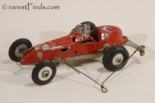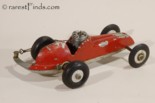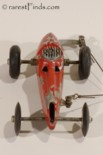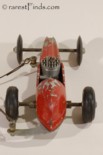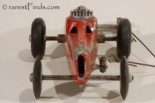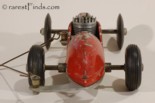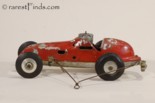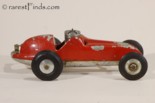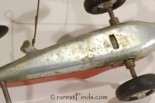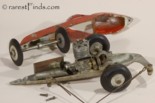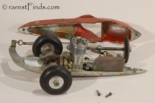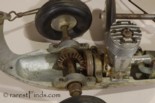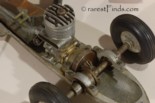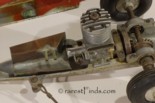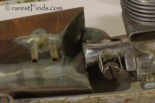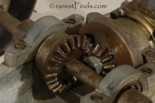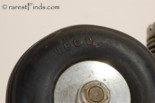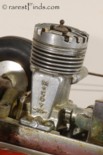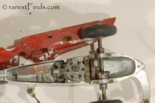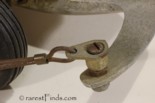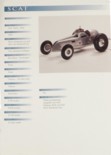Exceedingly rare, one of 24 ever produced, Scat Tether Car from 1954. Price $3,750.00
Designed and produced by Bob Snodgrass of Pac-A-Lite Mfg. Co., in Mount Morris, Michigan, powered by a McCoy 0.19 cubic inch engine, this Scat miniature model tether race car is as rare as hen’s teeth. All four wheels utilize ball bearings.
According to Eric Zausner’s book, Spindizzies, Gas Powered Model Racers [1], there were only 25 (twenty five!) of these Scat racers ever built. This and other information about the Scat tether car can be found on page 215 in [1], of which I included a picture above (see last picture, picture #21). According to the information on page 215 in [1], there are no reproductions of the Scat made. This was still true in 1998, when the book was printed.
In comparison, the most affordable tether car model, the Cox Thimble Drome Champion has a production run of 7,500 units (page 208 in [1]); in other words, a collector will find 300 times more likely a Cox Thimble Drome Champion than a Scat.
The fact that only 25 (original) Scat tether cars were ever built explains why I can’t find a past sales price of an original Scat; it is actually very difficult to find any information on the Scat tether car.
The comprehensive hardcover book, Vintage Miniature Racing Cars, by Bob Ames [2], does not even mention the Scat model offered here!
One of the largest collections of tether cars, the legendary Dick Barbour collection, which included 100 investment quality tether cars sold in February 2024 at Richmondauctions.com. Even Dick Barbour never managed to add a Scat tether car to his legendary collection as there was NONE included in said auction!
Eric Zausner’s book is a beautiful book with astonishing large format photographs of these amazing miniture race cars, one of my favorite books! On page 47 in his book [1] also shows the Scat tether racer with the caption “A selection of rare vintage mite cars: Papina, Hornet, Martin Flash and Scat (unpainted aluminium)”. The overall length of this car is 10⅜ inches.
Pac-A-Lite Co., also advertised a smaller version of the Scat, the Scat Cat tether car, see image on the right, (click on image to download a larger image!).
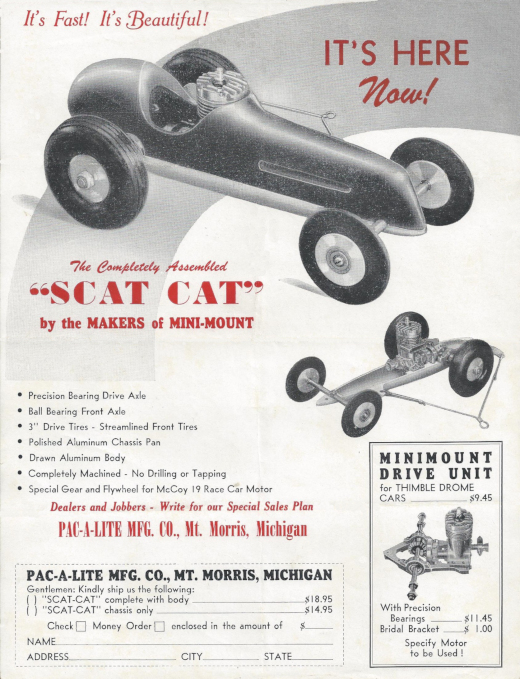 However, the Scat Cat remains an illusive model as well and only very few original examples are extant.
However, the Scat Cat remains an illusive model as well and only very few original examples are extant.
According to the advertisement, Pac-A-Lite Mfg. Co., also sold a “MINIMOUNT DRIVE UNIT” to hobbyists which built their own tether car but had not the capability to machine a drive unit; I wonder how common these units are.
Condition:
First of all, the Scat offered here is not a reproduction car; this is the real thing! Reproduction Scat cars sell for as much as $2,750.00 (January 14, 2013, on eBay).
I never tried to run the engine. However, I turned the engine and it has very good compression. The gears, as you can see, are in very good condition. This original vintage Scat tether car is all complete, and in very good condition. The red paint, I assume original to the car, is flaking off, see picture #19, showing some paint particles which came off just by handling the car. This might be the reason why the original Scat car shown on page 215, in [1], is all aluminum with the paint removed?
The wheels and tires are original too and show slight cracks from age. The under carriage of this rare Scat tether car has not one scratch!
There are also not any signs of repairs or defects; even the screws are still original.
History:
Progressive, innovative young men fitted model airplane engines to home-built miniature race cars and a new form of competitive racing was born. This happened after Charles Lindberg’s first crossing of the Atlantic in 1927 sparked an interest in flying. Real airplanes were out of reach for most, and models needed engines to fly.
As soon as model engines were first used to power planes, model race cars soon followed.
Tom Dooling built his first racer in 1937 and soon a hobby store owner offered to distribute his tether model race cars on the west coast; to read the history behind the Dooling brothers written by Adrian Duncan,
click here!
Within three years there were fifty-five firms manufacturing and selling miniature racers and parts.
Cars first ran on banked oval tracks guided by steel rails, later on a string attached to a pole in the middle of a circle-track, hence tether cars.
But the craze really spread like a wild fire after one thousand spectators attended a race organized as part fo the 1939 World’s Fair Exhibition in New York City. A front-drive Dooling won the race on the 50 foot radius circle with a top-speed of 36mph.
Roy Imhoff of Fresno California, at an event in Sacramento in 1941, was the first to break the 100mph speed barrier.
As the USA was drawn into World War II by the attack of Pearl Harbor by the Japanese on December 7, 1941, the production of model race cars came to a halt.
Unbelievably, considering there was a war going on, the first British tracks were built in the years 1942 and 1943, and apparently of only 13 to 14ft diameter. 1945 saw the first proper track of 42ft diameter built by Gerry Buck and colleagues in his parents’ garden in Stoke, and shortly after that, the famous Model Sportsdrome at Eaton Bray was opened. Eaton Bray sported a 72ft diameter track, which became the standard imperial size, as it gave six laps to the ¼ mile. Both of these pioneering activities have been documented elsewhere, and the stories associated with each could form the content of a complete talk.
1952 is an important reference point as it was the year in which FEMA (Federation Europeene du Modelisme Automobile) the European governing body was founded and also the year in which the first European Championships were held, at the now long - defunct track in Geneva, Switzerland. This really marks the beginning of the ‘modern era’ of tether car racing.
Classic tether cars are highly collectable and rare ones fetch prices above $10'000.
To this day, this hobby is still capturing the hards of many enthusiasts and there is even an Association organizing gatherings and races, here a link to the American Miniature Racing Car Association website.
Literature:
[1]
Spindizzies, Gas Powered Model racers, by Eric Zausner (1998), ISBN 0966723902
[2]
Vintage Miniature Racing Cars, by Bob Ames (1992, only 1,500 copies were printed), ISBN 1-55868-121-3
Inventory Number 09365;
Price: $ 3,750.00.
Prices realized in the past:
My best effort did not produce one single price result for an original Scat car!
On rare occasions, other original tether cars show up at auctions or on eBay, rare once fetching prices up to $12,240.00, (Don Edmunds Bb Korn Tether Car, sold on March 12, 2023, by Bertoia Auctions).
There are also reproduction cars sold to quench the demand of collectors of these exciting miniature race cars, including reproduction Scat cars.
